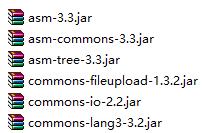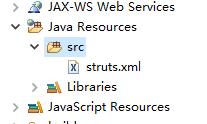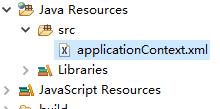SSH(Struts2+Spring+Hibernate)框架搭建流程
Posted 1270803966
tags:
篇首语:本文由小常识网(cha138.com)小编为大家整理,主要介绍了SSH(Struts2+Spring+Hibernate)框架搭建流程相关的知识,希望对你有一定的参考价值。
因为最近的学习使用到SSH框架,为了更加的了解SSH框架的搭建流程,我就具体的描述一下
我使用的是eclipse4.6、Tomcat8、JDK1.8,数据库mysql5.6
我下载的是Struts-2.3.30、Spring-4.2.2、Hibernate5.2.2
我已经给大家整理好所用到的包Struts-2.3.30.rar、Spring-4.2.2.rar、Hibernate5.2.2.rar(单击即可下载)
下载完成后,开始搭建
一、Struts2(MVC)的搭建:
相关描述
Ⅰ.本质上相当于一个Servlet
Ⅱ.不需要手动获取传递参数 (只需要定义声明属性名和设置get、set的方法)、也不需要手动跳转(只需要struts.xml配置相关的路径)
Ⅲ.对项目的分包(例如:dao、service、entity等等),实现MVC模式的开发
Ⅳ.MVC: Action属于Model,而JSP是View页面的展示,其中过滤器起到了Controller的作用
实现流程
1.首先新建一个项目
2.把下载好的Struts-2.3.30解压后,找到struts-2.3.30\\apps\\ struts2-blank.war \\WEB-INF\\lib的jar包,复制到项目的WebContent\\WEB-INF\\lib目录下



3.打开WebContent\\WEB-INF\\lib\\web.xml,定义过滤器,编辑如下
1 <filter> 2 <filter-name>struts2</filter-name> 3 <filter-class>org.apache.struts2.dispatcher.ng.filter.StrutsPrepareAndExecuteFilter</filter-class> 4 </filter> 5 <filter-mapping> 6 <filter-name>struts2</filter-name> 7 <url-pattern>/*</url-pattern> 8 </filter-mapping>
在src目录下新建一个类,必须继承ActionSupport父类才是Action类,编辑如下

1 //默认方法,struts自动调用 2 public class IndexAction extends ActionSupport { 3 public String execute() { 4 //默认返回值 5 return "success"; 6 } 7 }
4.在项目的src目录下新建一个struts.xml文件
 编辑如下
编辑如下
1 <?xml version="1.0" encoding="UTF-8" ?> 2 <!DOCTYPE struts PUBLIC 3 "-//Apache Software Foundation//DTD Struts Configuration 2.3//EN" 4 "http://struts.apache.org/dtds/struts-2.3.dtd"> 5 <!-- 上面的头,注意版本,从样例里复制过来 showcase.war\\WEB-INF\\src\\java\\struts.xml --> 6 <struts> 7 <package name="mypck" extends="struts-default"> 8 <!—name对应的action请求名称,method(不写等于默认方法)默认执行方法是 execute,class定义具体的类--> 9 <action name="Index" class="ssh.action.IndexAction" method="execute"> 10 <!-- 接收Action类返回的值,进行跳转指定的页面 --> 11 <result name="success">/WEB-INF/jsp/index.jsp</result> 12 <result name="error">/WEB-INF/jsp/error.jsp</result> 13 </action> 14 </package> 15 </struts>
完成以上流程,基本上Struts2的搭建就ok了
二、Spring(注入实例)的使用:
相关描述
Ⅰ.每一层的代码之间的耦合改为模块(分离/解耦),代码之间互不影响
Ⅱ.不再关注具体的实现类的实例
Ⅲ.更换不同的技术(模块),不需要改动代码,只需要修改applicationContext.xml的相关配置信息
Ⅳ.主要功能IOC(控制反转)松耦合、AOP (面向切面)内聚性
实现流程
1.首先在Struts2搭建基础上,再把下载好的Spring-4.2.2解压后,找到spring-framework-4.2.2.RELEASE\\libs的jar包,复制到项目的WebContent\\WEB-INF\\lib目录下
(注意: 包含<Javadoc、sources源码>的都可以不要)



(注意:导入Spring的包还不够,还差了Struts-2.3.30包里的struts-2.3.30-all\\struts-2.3.30\\apps\\struts2-showcase.war\\WEB-INF\\lib的两个jar包)
2. 编辑web.xml文件,定义监听器 ,添加下列代码
1 <!-- 不写默认Spring需要读取 WebContent\\WEB-INF\\applicationContext.xml--> 2 <context-param> 3 <param-name>contextConfigLocation</param-name> 4 <!-- 改变默认读取路径为src目录下的 applicationContext.xml--> 5 <!-- 在改变的路径下还是没找到,便自动到默认路径查找 --> 6 <param-value>classpath:applicationContext.xml</param-value> 7 </context-param> 8 <!-- 定义监听器 --> 9 <listener> 10 <listener-class>org.springframework.web.context.ContextLoaderListener</listener-class> 11 </listener>
3.在src目录下新建applicationContext.xml用作编写Spring
 编写如下(注意:本例没有为Action类注入实例,以下注入只提供参考)
编写如下(注意:本例没有为Action类注入实例,以下注入只提供参考)
1 <?xml version="1.0" encoding="UTF-8"?> 2 <beans xmlns="http://www.springframework.org/schema/beans" 3 xmlns:xsi="http://www.w3.org/2001/XMLSchema-instance" 4 xmlns:p="http://www.springframework.org/schema/p" 5 xmlns:aop="http://www.springframework.org/schema/aop" 6 xmlns:context="http://www.springframework.org/schema/context" 7 xmlns:jee="http://www.springframework.org/schema/jee" 8 xmlns:tx="http://www.springframework.org/schema/tx" 9 xsi:schemaLocation=" 10 http://www.springframework.org/schema/aop http://www.springframework.org/schema/aop/spring-aop-4.2.xsd 11 http://www.springframework.org/schema/beans http://www.springframework.org/schema/beans/spring-beans-4.2.xsd 12 http://www.springframework.org/schema/context http://www.springframework.org/schema/context/spring-context-4.2.xsd 13 http://www.springframework.org/schema/jee http://www.springframework.org/schema/jee/spring-jee-4.2.xsd 14 http://www.springframework.org/schema/tx http://www.springframework.org/schema/tx/spring-tx-4.2.xsd"> 15 <!-- 上面的头,注意版本,从样例里复制过来 --> 16 <!-- id定义名字,class具体的类,scope="prototype"定义非单例 --> 17 <bean id="myActionIndex" class="ssh.action.IndexAction" scope="prototype"> 18 <!-- 本例没有 --> 19 <!-- 为Action类里的is属性注入id为myIndexService的实例 --> 20 <property name="is" ref="myIndexService" /> 21 </bean> 22 <!-- 本例没有 --> 23 <bean id="myIndexService" class="ssh.service.IndexServiceImpl" scope="prototype"> 24 </bean> 25 </beans>
1 //本例没有 2 public class IndexAction extends ActionSupport { 3 4 //声明service,但不给它创建具体的实现类的实例, 5 private IndexService is = null; 6 public void setIs(IndexService is) { 7 this.is = is; 8 } 9 }
4.编辑struts.xml文件,添加下列代码(注意:新版本可以不用写,包括本例)
1 <struts> 2 <!-- 告知Struts2运行时使用Spring来创建对象 --> 3 <constant name="struts.objectFactory" value="spring" /> 4 </struts>
改写action里的class属性
1 <!-- class改写成Spring注入的id定义的名字 --> 2 <action name="Index" class="ssh.action.IndexAction" method="execute">
完成以上流程,基本上Struts2-Spring的搭建就ok了
三、Hibernate(数据层)的搭建:
相关描述
Ⅰ.服务器与数据库之间的交互
Ⅱ. Hibernate封装了一系列的JDBC代码,提供相应的方法我们使用,使我们的开发变得简单快捷,效率大大提高
实现流程
1. 首先在Struts2-spring搭建基础上,再把下载好的Hibernate5.2.2解压后,找到hibernate-release-5.2.2.Final\\lib\\required的jar包,复制到项目的WebContent\\WEB-INF\\lib目录下(注意:本例使用是MySQL,记得导入对应的数据库驱动包)


2.编写applicationContext.xml文件,添加以下代码,用作描述具体的数据库信息(定义1个sessionFactory,用作于注入)
1 <bean id="sessionFactory" class="org.springframework.orm.hibernate5.LocalSessionFactoryBean"> 2 <!-- 注入连接池,包含了数据库用户名,密码等等信息 --> 3 <property name="dataSource" ref="myDataSource"></property> 4 <property name="hibernateProperties"> 5 <props> 6 <!-- 数据库的方言 --> 7 <prop key="hibernate.dialect">org.hibernate.dialect.MySQL5Dialect</prop> 8 <!-- 是否显示打印sql语句--> 9 <prop key="hibernate.show_sql">true</prop> 10 <!-- 是否格式化显示sql语句--> 11 <prop key="hibernate.format_sql">true</prop> 12 <!-- 是否自动提交--> 13 <prop key="hibernate.connection.autocommit">false</prop> 14 <!-- 没表帮你创建表,有表就更新表信息 --> 15 <prop key="hibernate.hbm2ddl">update</prop> 16 </props> 17 </property> 18 <property name="mappingResources"> 19 <list> 20 <!-- 映射文件路径(实体类) --> 21 <value>ssh/entity/BookCard.hbm.xml</value> 22 </list> 23 </property> 24 </bean>
3.为c3p0数据池导入相应的jar包,在Hibernate5.2.2压缩包hibernate-release-5.2.2.Final\\lib\\optional\\c3p0的3个jar包, 复制到项目的WebContent\\WEB-INF\\lib目录下(提议:也可以使用..\\optional\\dbcp的数据池)(区别:c3p0:稳定性、dbcp:速度比较快)

4. 继续编写applicationContext.xml文件,添加以下代码(为sessionFactory注入一个c3p0数据库)
1 <!-- 定义c3p0数据池 --> 2 <bean id="myDataSource" class="com.mchange.v2.c3p0.ComboPooledDataSource"> 3 <!-- 数据库的驱动 --> 4 <property name="driverClass" value="com.mysql.jdbc.Driver"/> 5 <!-- 数据库的路径 --> 6 <property name="jdbcUrl" value="jdbc:mysql://localhost:3306/CardDB"/> 7 <!-- 数据库的用户名 --> 8 <property name="user" value="root"/> 9 <!-- 数据库的密码 --> 10 <property name="password" value="123456"/> 11 <!-- 每300秒检查所有连接池中的空闲连接 --> 12 <property name="idleConnectionTestPeriod" value="300"></property> 13 <!-- 最大空闲时间,900秒内未使用则连接被丢弃。若为0则永不丢弃 --> 14 <property name="maxIdleTime" value="900"></property> 15 <!-- 最大连接数 --> 16 <property name="maxPoolSize" value="2"></property> 17 </bean>
5.第4步也可以替换成,以下写法,先在src目录下创建一个jdbc.properties的文件(用于记录保存数据库相关的信息)

1 jdbc.driver=com.mysql.jdbc.Driver 2 jdbc.url=jdbc:mysql://localhost:3306/CardDB 3 jdbc.user=root 4 jdbc.password=123456
然后applicationContext.xml文件就可以引用该文件内的参数
1 <property name="driverClass" value="${jdbc.driver}"/> 2 <property name="jdbcUrl" value="${jdbc.url}"/> 3 <property name="user" value="${jdbc.user}"/> 4 <property name="password" value="${jdbc.password}"/>
(注意:引用前提必须要在applicationContext.xml文件里添加以下代码,声明一下引用的文件路径)
1 <context:property-placeholder location="classpath:jdbc.properties.txt" />
6.最后在实体类的目录下新建一个实体类.hbm.xml的文件,进行以下编辑
1 <?xml version="1.0" encoding="UTF-8"?> 2 <hibernate-mapping xmlns="http://www.hibernate.org/xsd/hibernate-mapping"> 3 <!-- name是实体类的具体路径,table是定义创建表的名字 --> 4 <class name="ssh.entity.BookCard" table="BookCard"> 5 <!-- 定义主键的名称 --> 6 <id name="cid" column="cid"> 7 <!-- 定义主键为自动增长 --> 8 <generator class="native"></generator> 9 </id> 10 <!-- 定义数据库的其他的字段 的具体描述--> 11 <property name="name" type="string" length="50" column="name" not-null="true"></property> 12 <property name="sex" type="string" length="2" column="sex"></property> 13 <property name="cardDate" type="date" column="cardDate"></property> 14 <property name="deposit" type="double" column="deposit"></property> 15 </class> 16 </hibernate-mapping>
以上就是一个简单的SSH搭建的流程
以上是关于SSH(Struts2+Spring+Hibernate)框架搭建流程的主要内容,如果未能解决你的问题,请参考以下文章